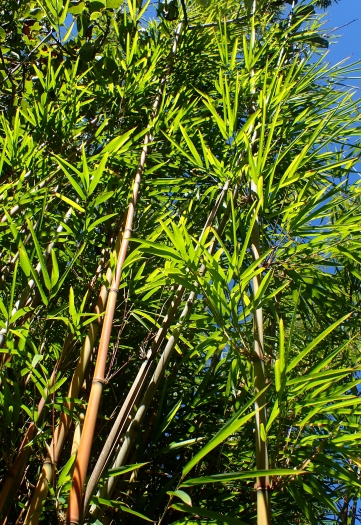Blue Bamboo
(Calamus hookerianus)
Blue Bamboo (Calamus hookerianus)
/
/

Krzysztof Ziarnek, Kenraiz
CC BY-SA 4.0
Image By:
Krzysztof Ziarnek, Kenraiz
Recorded By:
Copyright:
CC BY-SA 4.0
Copyright Notice:
Photo by: Krzysztof Ziarnek, Kenraiz | License Type: CC BY-SA 4.0 | License URL: https://creativecommons.org/licenses/by-sa/2.0 | Uploader: Kenraiz | Publisher: Wikimedia Commons |


Estimated Native Range
Summary
Calamus hookerianus, commonly known as Blue Bamboo, is an evergreen perennial grass native to the tropical forests of Northeast India and parts of Southeast Asia. It can reach heights of 10-18 feet (3-5.5 meters) with a clumping growth habit, and typically spreads 8-15 feet (2.4-4.6 meters) wide. Blue Bamboo is characterized by its striking blue-green culms and lush foliage, which add a tropical feel to the landscape. The plant does not produce notable flowers or fruit, but its colorful canes and dense foliage are the main ornamental features.
Blue Bamboo is valued for its fast growth and the visual impact of its colorful canes. It is used in gardens and landscapes for creating privacy screens, as a focal point, or for adding an exotic touch to plantings. It is adaptable to a range of soil types, provided they are well-draining, and it requires consistent moisture for optimal growth. While it thrives in full sun to part shade, in hotter climates, some afternoon shade can prevent leaf scorch. It is relatively low maintenance but may require occasional thinning to manage its spread. Blue Bamboo is not known for serious pest or disease issues, but it can become invasive if not contained, so gardeners should consider root barriers or containment strategies when planting.CC BY-SA 4.0
Blue Bamboo is valued for its fast growth and the visual impact of its colorful canes. It is used in gardens and landscapes for creating privacy screens, as a focal point, or for adding an exotic touch to plantings. It is adaptable to a range of soil types, provided they are well-draining, and it requires consistent moisture for optimal growth. While it thrives in full sun to part shade, in hotter climates, some afternoon shade can prevent leaf scorch. It is relatively low maintenance but may require occasional thinning to manage its spread. Blue Bamboo is not known for serious pest or disease issues, but it can become invasive if not contained, so gardeners should consider root barriers or containment strategies when planting.CC BY-SA 4.0
Plant Description
- Plant Type: vine
- Height: 10-18 feet
- Width: 8-15 feet
- Growth Rate: Rapid
- Flower Color: N/A
- Flowering Season: Non-Flowering
- Leaf Retention: Evergreen
Growth Requirements
- Sun: Full Sun, Part Shade
- Water: Medium
- Drainage: Medium
Common Uses
Erosion Control, Low Maintenance
Natural Habitat
Tropical forests of Northeast India and parts of Southeast Asia
Other Names
Common Names:
Scientific Names: , Calamus hookerianus,
GBIF Accepted Name: Calamus hookerianus Becc.